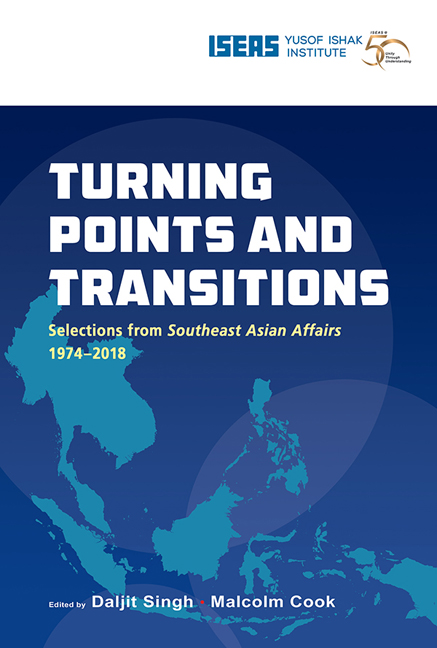Book contents
- Frontmatter
- Contents
- Message from the Director
- Foreword
- Foreword
- Introduction
- THE REGION
- BRUNEI
- CAMBODIA
- INDONESIA
- LAOS
- MALAYSIA
- MYANMAR
- THE PHILIPPINES
- SINGAPORE
- THAILAND
- The Revolutionary Situation in Thailand (1975)
- American Military Withdrawal from Thailand (1976)
- The Thai Economy: From Boom to Gloom? (1997)
- Thailand: A Year of Diminishing Expectations (1999)
- Thailand: A Reckoning with History Begins (2007)
- What Went Wrong with the Thai Democracy? (2015)
- VIETNAM
American Military Withdrawal from Thailand (1976)
from THAILAND
Published online by Cambridge University Press: 29 May 2019
- Frontmatter
- Contents
- Message from the Director
- Foreword
- Foreword
- Introduction
- THE REGION
- BRUNEI
- CAMBODIA
- INDONESIA
- LAOS
- MALAYSIA
- MYANMAR
- THE PHILIPPINES
- SINGAPORE
- THAILAND
- The Revolutionary Situation in Thailand (1975)
- American Military Withdrawal from Thailand (1976)
- The Thai Economy: From Boom to Gloom? (1997)
- Thailand: A Year of Diminishing Expectations (1999)
- Thailand: A Reckoning with History Begins (2007)
- What Went Wrong with the Thai Democracy? (2015)
- VIETNAM
Summary
American troops came into Thailand twice, in 1961 and 1963. They were contingents of Marines sent to this country when communist Pathet Lao forces advanced towards the Mekong River which serves as a border between Thailand and Laos. The objective was to deter the aggressive communist side from seeking excessive military and political gains in Laos. When the communist forces retreated, the Marines as well as other SEATO forces from the United Kingdom, Australia and New Zealand which joined the U.S. troops in 1963 were repatriated. The U.S. left only a contingent of Army Engineers to help build the strategic road from the naval base of Sattahip to Northeast Thailand.
Why did the U.S. want to send its armed forces into Thailand?
Since I am not an American and privy to the deliberations which led to such a decision, I can only guess at the reasons which a foreigner like myself can detect. As I see it, the reason is not of a selfish nature. The U.S. did not hope to derive any particular benefit from such a move. To my mind, the U.S., in those days, must have felt a sense of mission, a certain responsibility for safeguarding peace and preventing war, particularly aggressive wars. In other words, the U.S. was conscious of its role as “world policeman”, since it has been blamed for allowing wars to break out because it failed to take the necessary actions or to take part in the activities of international organizations like the League of Nations. As a result of those accusations, some of them unfounded, the U.S., since World War II, took it upon itself to bar the road to aggressors and to extinguish the flames of international conflicts. The despatch of U.S. Marines came within the purview of that mission.
Later on, perhaps around 1965 (the exact date is unknown to me as the talks or negotiations were conducted in secret between the then Prime Minister, Field Marshal Thanom Kittikachorn, and the American authorities), the U.S. sent its military personnel, drawn mostly from the Air Force, and war equipment into Thailand. As it was learnt later, this action was necessary because of greater U.S. involvement in the Vietnam War. The military aircraft and the use of air-bases in this country were needed to support U.S. operations in Vietnam.
- Type
- Chapter
- Information
- Turning Points and TransitionsSelections from Southeast Asian Affairs 1974-2018, pp. 644 - 648Publisher: ISEAS–Yusof Ishak InstitutePrint publication year: 2018

